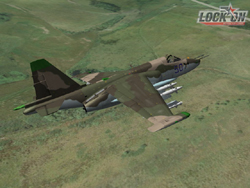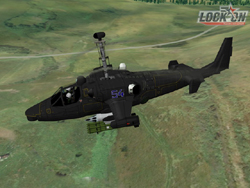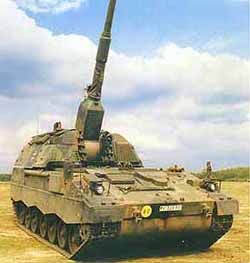Daily News
by Gail Helmer
[ Send Us News | Archives ]
New Screens: LO:MAC
Ubi Soft's latest screens from Lock On: Modern Air Combat. These two screen shots show the Su-25 attack jet and the Ka-52 attack helicopter flying low over Lock On's new ultra-high density texture terrain system.


Medal of Honor Add-on
Electronic Arts is developing an expansion pack to Medal of Honor: Allied Assault. Tentatively called Medal of Honor: Team Assault, this add-on will contain nine new single-player levels, 12 new multiplayer maps, and a new team-based gameplay mode, as well as a number of new Russian and British weapons and character models. While many details about the game are still unknown, we do know that its overall focus will be on the eastern front of World War II, a theater of war that wasn't covered in the original Allied Assault.
Team Assault is currently being developed at EALA, not 2015, the Oklahoma-based studio that created the original game. The expansion is tentatively scheduled for release in November or December of this year, and it will require a full version of Medal of Honor: Allied Assault to run. We'll update you with more details on this anticipated add-on as they become available.
Military News
Northrop Grumman Delivers First AMES III EW Simulator
Northrop Grumman Corporation's Amherst Systems business unit has delivered the first stage of its AMES III electronic warfare threat simulator system to the U.S. Naval Air Warfare Center at Patuxent River, Md.
The AMES III is the latest generation of Amherst Systems' AMES product line and the most advanced simulator in the company's portfolio. AMES III is a Windows NT/2000™ based modular state-of-the-art electronic warfare threat simulation system capable of generating a radar threat environment of over 2000 complex emitters.
"The AMES III simulator will provide our customers with real-time threat simulation dynamics and full-suite capability for laboratory and anechoic chamber applications," said Ed Eberl, president of Amherst Systems, a unit of Northrop Grumman's Electronic Systems sector. "The system also provides full radar-spectrum coverage and high fidelity for development of the most complex threat data bases and scenarios."
The AMES product line provides modular electronic warfare threat simulation systems that can be readily expanded and customized. Enhanced over a period of 20 years, AMES is designed to meet the multiple customer requirements for test and evaluation of radar warning receivers, electronic countermeasures and electronic support measures.
Crusader Set To Be Cancelled As Rumsfeld Flexes Muscles
The Army's prized Crusader artillery system looks set to be the first high profile US military project to be cut from the budget as Secretary for Defense Donald Rumsfeld seeks to transform America's fighting force from Cold War leviathan to 21st Century machine. However, it seems likely that Rumsfeld and his cohorts will face a battle from the Army as well as walking the minefield of the lobbying system on Capitol Hill, before the demise of the Crusader project becomes a reality.
The Army was planning to purchase 430 Crusaders to replace the ageing Paladin armaments currently in service at a cost of more than $9 billion. The decision-makers within the Department of Defense (DoD) clearly consider there to be more efficient ways of allocating this amount of money. The Crusader only survived the 2001 Defence review as it was scaled down from its original 60 tonnes to approximately 40.

"The battlefield of the future is going to be represented by very precise target location, digital terrain mapping and very precision weapons delivery," said Under Secretary of Defense Pete Aldridge at a press conference. "If you look at what is the best way in the future to achieve a capability for the Army that's in the best interest, it is providing the Army with a quicker pace to achieve the technologies that are associated with this type of battlefield environment, get precision weapons to the Army faster."
Although the decision to kill the programme has not yet been confirmed the writing appears to be on the wall as Defense Secretary Rumsfeld has asked the Army to draw up an artillery study without the Crusader. "The Army has been tasked to come in with a plan that would include the cancellation of Crusader within 30 days, with a description of what the concept would look like with a lot of different variables in it," said Aldridge.
The plan has already met with resistance within Army ranks and has caused hurried consternation among Congressmen from both Houses representing Oklahoma, where the Crusader would have been produced. The Crusader may well represent a test case for Rumsfeld as he tries to develop the kind of regime that will streamline US defence spending.
Six other military projects that had come under scrutiny under the Nunn-McCurdy act have been granted a stay of execution. Nunn-McCurdy requires any project that exceeds its budgetary allowance by 25% to be reviewed. Four criteria have to be reviewed, importance to national security, project management, cost control, and availability of alternatives.
The six projects include two helicopter re-manufacturing programmes - the H-1 for the AH-1 Cobra and for the UH-1 Huey replacement, and the CH-47 for the light helicopter replacement. The project to build the LPD-17amphibious transport dock ship has also been retained and the chemical demilitarisation programme will continue. A multiple-launch rocket system upgrade, that is a joint project between the US, Germany, France, Italy and the UK will go ahead. Perhaps most importantly in terms of national security, the space-based infrared radar system (SBIRS High), which is the replacement for the current ballistic missile early warning system, will be persevered with.
However, if in thirty days the Crusader project does go to the scrapheap, the administrators of other high-profile programmes will start to look over their shoulders. First among these could well be the V-22 Osprey, which will shortly embark on a make or break 9-month flight test programme.
The Netherlands Sign PZH 2000 SP Howitzers Contract
The Netherlands has signed a procurement contract for 57 Krauss-Maffei Wegmann built PzH 2000 self-propelled howitzers and peripheral equipment for the Royal Netherlands Army. Delivery will start in 2004 and be concluded in 2009.
The PzH 2000 is to replace the older systems M 114 and M 109 which no longer meet today's battlefield requirements for artillery systems. The German howitzer beat off competitors from the USA, South Africa, and the United Kingdom.

The Netherlands has bought a number of Krauss-Maffei Wegmann systems such as LEOPARD 1, LEOPARD 2, CHEETAH, FENNEK and, most recently, the trilateral GTK/MRAV/ PWV Multi-Role Armoured Vehicle development.
Italy has already selected PzH 2000 and decided its procurement. Contracts may be signed this year. Sweden started a 2 years "Demonstrator Programme" with PzH 2000 in October 2001. Greece's 24 PzH 2000 systems will be delivered between 2003 and 2004.PzH 2000 will be supported by a logistic partnership between the user countries, making for operational and life cycle cost reductions.
[ Send Us News | Archives ]
by Gail Helmer
Friday May 03, 2002
- New Screens: LO:MAC
- Medal of Honor Add-on
- Northrop Grumman Delivers First AMES III EW Simulator
- Crusader Set To Be Cancelled As Rumsfeld Flexes Muscles
- The Netherlands Sign PZH 2000 SP Howitzers Contract
New Screens: LO:MAC
Ubi Soft's latest screens from Lock On: Modern Air Combat. These two screen shots show the Su-25 attack jet and the Ka-52 attack helicopter flying low over Lock On's new ultra-high density texture terrain system.


Medal of Honor Add-on
Electronic Arts is developing an expansion pack to Medal of Honor: Allied Assault. Tentatively called Medal of Honor: Team Assault, this add-on will contain nine new single-player levels, 12 new multiplayer maps, and a new team-based gameplay mode, as well as a number of new Russian and British weapons and character models. While many details about the game are still unknown, we do know that its overall focus will be on the eastern front of World War II, a theater of war that wasn't covered in the original Allied Assault.
Team Assault is currently being developed at EALA, not 2015, the Oklahoma-based studio that created the original game. The expansion is tentatively scheduled for release in November or December of this year, and it will require a full version of Medal of Honor: Allied Assault to run. We'll update you with more details on this anticipated add-on as they become available.
Military News
Northrop Grumman Delivers First AMES III EW Simulator
Northrop Grumman Corporation's Amherst Systems business unit has delivered the first stage of its AMES III electronic warfare threat simulator system to the U.S. Naval Air Warfare Center at Patuxent River, Md.
The AMES III is the latest generation of Amherst Systems' AMES product line and the most advanced simulator in the company's portfolio. AMES III is a Windows NT/2000™ based modular state-of-the-art electronic warfare threat simulation system capable of generating a radar threat environment of over 2000 complex emitters.
"The AMES III simulator will provide our customers with real-time threat simulation dynamics and full-suite capability for laboratory and anechoic chamber applications," said Ed Eberl, president of Amherst Systems, a unit of Northrop Grumman's Electronic Systems sector. "The system also provides full radar-spectrum coverage and high fidelity for development of the most complex threat data bases and scenarios."
The AMES product line provides modular electronic warfare threat simulation systems that can be readily expanded and customized. Enhanced over a period of 20 years, AMES is designed to meet the multiple customer requirements for test and evaluation of radar warning receivers, electronic countermeasures and electronic support measures.
Crusader Set To Be Cancelled As Rumsfeld Flexes Muscles
The Army's prized Crusader artillery system looks set to be the first high profile US military project to be cut from the budget as Secretary for Defense Donald Rumsfeld seeks to transform America's fighting force from Cold War leviathan to 21st Century machine. However, it seems likely that Rumsfeld and his cohorts will face a battle from the Army as well as walking the minefield of the lobbying system on Capitol Hill, before the demise of the Crusader project becomes a reality.
The Army was planning to purchase 430 Crusaders to replace the ageing Paladin armaments currently in service at a cost of more than $9 billion. The decision-makers within the Department of Defense (DoD) clearly consider there to be more efficient ways of allocating this amount of money. The Crusader only survived the 2001 Defence review as it was scaled down from its original 60 tonnes to approximately 40.

"The battlefield of the future is going to be represented by very precise target location, digital terrain mapping and very precision weapons delivery," said Under Secretary of Defense Pete Aldridge at a press conference. "If you look at what is the best way in the future to achieve a capability for the Army that's in the best interest, it is providing the Army with a quicker pace to achieve the technologies that are associated with this type of battlefield environment, get precision weapons to the Army faster."
Although the decision to kill the programme has not yet been confirmed the writing appears to be on the wall as Defense Secretary Rumsfeld has asked the Army to draw up an artillery study without the Crusader. "The Army has been tasked to come in with a plan that would include the cancellation of Crusader within 30 days, with a description of what the concept would look like with a lot of different variables in it," said Aldridge.
The plan has already met with resistance within Army ranks and has caused hurried consternation among Congressmen from both Houses representing Oklahoma, where the Crusader would have been produced. The Crusader may well represent a test case for Rumsfeld as he tries to develop the kind of regime that will streamline US defence spending.
Six other military projects that had come under scrutiny under the Nunn-McCurdy act have been granted a stay of execution. Nunn-McCurdy requires any project that exceeds its budgetary allowance by 25% to be reviewed. Four criteria have to be reviewed, importance to national security, project management, cost control, and availability of alternatives.
The six projects include two helicopter re-manufacturing programmes - the H-1 for the AH-1 Cobra and for the UH-1 Huey replacement, and the CH-47 for the light helicopter replacement. The project to build the LPD-17amphibious transport dock ship has also been retained and the chemical demilitarisation programme will continue. A multiple-launch rocket system upgrade, that is a joint project between the US, Germany, France, Italy and the UK will go ahead. Perhaps most importantly in terms of national security, the space-based infrared radar system (SBIRS High), which is the replacement for the current ballistic missile early warning system, will be persevered with.
However, if in thirty days the Crusader project does go to the scrapheap, the administrators of other high-profile programmes will start to look over their shoulders. First among these could well be the V-22 Osprey, which will shortly embark on a make or break 9-month flight test programme.
The Netherlands Sign PZH 2000 SP Howitzers Contract
The Netherlands has signed a procurement contract for 57 Krauss-Maffei Wegmann built PzH 2000 self-propelled howitzers and peripheral equipment for the Royal Netherlands Army. Delivery will start in 2004 and be concluded in 2009.
The PzH 2000 is to replace the older systems M 114 and M 109 which no longer meet today's battlefield requirements for artillery systems. The German howitzer beat off competitors from the USA, South Africa, and the United Kingdom.

The Netherlands has bought a number of Krauss-Maffei Wegmann systems such as LEOPARD 1, LEOPARD 2, CHEETAH, FENNEK and, most recently, the trilateral GTK/MRAV/ PWV Multi-Role Armoured Vehicle development.
Italy has already selected PzH 2000 and decided its procurement. Contracts may be signed this year. Sweden started a 2 years "Demonstrator Programme" with PzH 2000 in October 2001. Greece's 24 PzH 2000 systems will be delivered between 2003 and 2004.PzH 2000 will be supported by a logistic partnership between the user countries, making for operational and life cycle cost reductions.
